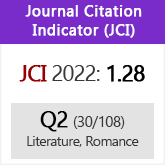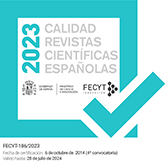Espacio(s) teatral(es) y diversidad funcional
DOI:
https://doi.org/10.3989/revliteratura.2019.01.003Palabras clave:
disability studies, teatro contemporáneo, inclusiónResumen
Esta contribución se plantea de qué manera actores con diversidad funcional cambian el espacio teatral. Se parte de la hipótesis de que las anomalías corporales hacen consciente la superposición de los dos hic et nunc del teatro, uno estético/simbólico y otro, físico/concreto. Tres ejemplos del teatro contemporáneo ilustran cómo este hecho se deja utilizar estéticamente: Esta breve tragedia de la carne, de Angélica Liddell (2015), Disabled Theater (2012), de Jérôme Bel, y Mi piedra Rosetta, de José Ramón Fernández, realizado por David Ojeda (2012). El análisis mostrará que en estas obras, la relación entre espacio escénico y espacio del espectador es inseparable del impacto del espectáculo entero. Las tres obras enfocan los conceptos exclusión, inclusión e intercambio.
Descargas
Citas
Behrendt, Eva (2012). «Subjekt, Skulptur, Symbol», Theater heute. 7, pp. 11-13.
Bogdan, Robert (1988). Freak Show. Presenting Human Oddities for Amusement and Profit. Chicago: University of Chicago Press.
Davis, Lennard J. (1995). Enforcing Normalcy. Disability, Deafness, and the Body. London - New York: Verso.
Dederich, Markus (2012). Körper, Kultur und Behinderung. Eine Einführung in die Disability Studies. 2a ed. Bielefeld: Transcript.
Fernández, José Ramón (2013). «Mi piedra Rosetta», Primer acto. 344, I, pp. 157-183.
Fiedler, Leslie A. (1978). Freaks. Myths and Images of the Secret Self. New York: Simon and Schuster.
Garland Thomson, Rosemarie (1997). Extraordinary Bodies. Figuring physical disability in American culture and literature. New York: Columbia UP.
Garland Thomson, Rosemarie (2009). Staring. How We Look. Oxford: Oxford UP.
Garrido, Carmen (2013). «Circuit-on (I): Cuando todos podemos ser Bernarda Alba», Revista de Letras. 24 de abril. Accesible en: http://revistadeletras.net/circuit-on-i-cuando-todos-podemos-ser-bernarda-alba/ [acceso el 18/01/2016].
Hargrave, Matt (2015). Theatres of Learning Disability. Good, Bad, or Plain Ugly? Basingstoke: Palgrave Macmillan. https://doi.org/10.1057/9781137504395
Hartwig, Susanne (2003). «¿Alteridad monstruosa? - La estética de Angélica Liddell», en Susanne Hartwig y Klaus Pörtl (eds.), Identidad en el teatro español e hispanoamericano contemporáneo. Frankfurt am Main: Valentia, pp. 61-71.
Hartwig, Susanne (2003). «La mirada del Otro: la posición del espectador en el teatro español contemporáneo (Borja Ortiz de Gondra, Itziar Pascual, Angélica Liddell, Rodrigo García)», ALEC. 28 (2), pp. 35-60.
Hartwig, Susanne (2005). Chaos und System. Studien zum spanischen Gegenwartstheater. Frankfurt am Main: Vervuert. https://doi.org/10.31819/9783964565365
Hartwig, Susanne (2006). «Ante los monstruos: la "estética de feria" en el teatro contemporáneo», en José Romera Castillo (ed.), Tendencias escénicas al inicio del siglo XXI. Actas del XV Seminario Internacional del Centro de Investigación de Semiótica Literaria, Teatral y Nuevas Tecnologías, Madrid UNED, 27 al 29 de junio de 2005. Madrid: Visor, pp. 211-223.
Hartwig, Susanne (2007). «(Re)presentación de la locura: caras y máscaras», en Roswita y Emmanuelle Garnier (eds.), Transgression et folie dans les dramaturgies féminines hispaniques contemporaines. Carnières-Morlanwelz: Lansman, pp. 199-215.
Hartwig, Susanne (2014). «Hics et nuncs en el teatro contemporáneo», ALEC. 39 (2), pp. 417-437.
Heiner, Stefan (2003). «Nur zu meinen Bedingungen. Gespräch mit Peter Radtke», en Stefan Heiner (ed.), Bildstörungen. Kranke und Behinderte im Spielfilm. Frankfurt am Main: Mabuse, pp. 111-124.
Höhne, Gisela, Daniele Muscionico, Gerald Siegmund, Sandra Umathum y Benjamin Wihstutz (2014). «Gespräch über DISABLED THEATER am 30. Mai 2013, im Anschluss an die Vorstellung von DISABLED THEATER im Rahmen des internationalen Theaterfestivals OKKUPATION! in der Aktionshalle der Roten Fabrik, Zürich», en Marcel Bugiel y Michael Elber (eds.), Theater HORA. Der einzige Unterschied zwischen uns und Salvador Dalí ist, dass wir nicht Dalí sind. Berlin: Theater der Zeit, pp. 386-398.
Juárez-Almendros, Encarnación (2013). «Disability Studies in the Hispanic world: Proposal and Methodologies», Arizona Journal of Hispanic Cultural Studies. 17, pp. 153-160. https://doi.org/10.1353/hcs.2013.0015
Kuppers, Petra (2014). Studying Disability Arts and Culture. An Introduction. Basingstoke: Palgrave Macmillan. https://doi.org/10.1007/978-1-137-41344-4
Link, Jürgen (1998). Versuch über den Normalismus. Wie Normalität produziert wird. 2a ed. actual. y aum. Opladen - Wiesbaden: Westdeutscher Verlag.
Longmore, Paul K. (2003). «Screening Stereotypes: Images of Disabled People in Television and Motion Pictures», en Paul K. Longmore, Why I burned my book and other essays on disability. Philadelphia: Temple University Press, pp.131-146.
Mayorga, Juan (2013). «Cuerpos diferentes», Primer acto. 344, I, pp. 153-154.
Mitchell, David T. y Sharon L. Snyder (1997). «Introduction: Disability Studies and the double Bind of Representation», en David T. Mitchell and Sharon L. Snyder (eds.), The Body and Physical Difference. Discourses of Disability. Ann Arbor: The University of Michigan Press, pp. 1-31.
Mitchell, David T. y Sharon L. Snyder (2000). Narrative Prosthesis. Disability and the Dependencies of Discourse. Ann Arbor: The University of Michigan Press. https://doi.org/10.3998/mpub.11523
Mitchell, David T. y Sharon L. Snyder (2001). «Representation and Its Discontents. The Uneasy Home of Disability in Literature and Film», en Gary L. Albrecht, Katherine D. Seelman y Michael Bury (eds.), Handbook of Disability Studies. Thousand Oaks - London - New Delhi: Sage, pp. 195-218. https://doi.org/10.4135/9781412976251.n8 PMid:12105574
Muscionico, Daniele (2014). «Imperfektes Theater in der imperfekten Kritik», en Marcel Bugiel y Michael Elber (eds.) (2014). Theater HORA. Der einzige Unterschied zwischen uns und Salvador Dalí ist, dass wir nicht Dalí sind. Berlin: Theater der Zeit, pp. 140-143.
Öhlschläger, Claudia (2009). «Narration und Ethik. Vorbemerkung», en Claudia Öhlschläger (ed.), Narration und Ethik. München: Fink, pp. 9-21. https://doi.org/10.30965/9783846746387
Ojeda, David y Elena SV Flys (2015). «La creación espectacular con personas con discapacidad y la accesibilidad universal del arte y la cultura escénica», Acotaciones. 35, pp. 150-178. Accesible en: http://www.resad.com/Acotaciones/index.php/ACT/article/ view/33/68.
Ramos, Ángel (2013). «'Mi piedra Rosetta', teatro accesible para personas con discapacidades», Cáscara amarga. Periodismo y diversidad, 29 de abril. Accesible en: http:// www.cascaraamarga.es/cultura/50-cultura/5175-mi-piedra-rosetta-teatro-accesible.html [acceso el 19/04/2019].
Romañach, Javier y Manuel Lobato (2005). «Functional diversity, a new term in the struggle for dignity in the diversity of the human being», Independent Living Forum (Spain). Accesible en https://disability-studies.leeds.ac.uk/wp-content/uploads/sites/40/library/ zavier-Functional-Diversity-Romanach.pdf [acceso el 07/03/2016].
Roselt, Jens (2012). «Der Zuschauer als Täter. Von der Scham beim Spannen und Gaffen», en Imanuel Schipper (ed.), Ästhetik versus Authentizität? Reflexionen über die Darstellung von und mit Behinderung. Berlin: Theater der Zeit, pp. 81-91.
Schmidt, Yvonne (2012). «Perform to be a freak. Ein Ausflug in heutige Freakshows», en Imanuel Schipper (ed.), Ästhetik versus Authentizität? Reflexionen über die Darstellung von und mit Behinderung. Berlin: Theater der Zeit, pp. 118-129.
Siebers, Tobin (2012). «Un/sichtbar. Observationen über Behinderung auf der Bühne», en Imanuel Schipper (ed.), Ästhetik versus Authentizität? Reflexionen über die Darstellung von und mit Behinderung. Berlin: Theater der Zeit, pp. 16-32.
Tervooren, Anja (2003). «Der verletzliche Körper. Überlegungen zu einer Systematik der Disability Studies», en Anne Waldschmidt (ed.), Kulturwissenschaftliche Perspektiven der Disability Studies. Tagungsdokumentation. Kassel: bifos, pp. 37-48.
Umathum, Sandra (2015). «Actors, nonetheless», en Sandra Umathum y Benjamin Wihstutz. Disabled theater. Zürich - Berlin: Diaphanes, pp. 99-112.
Umathum, Sandra y Benjamin Wihstutz, (2015a). «Interview with Jérôme Bel. "It's All about Communication"» en Sandra Umathum y Benjamin Wihstutz. Disabled theater. Zürich - Berlin: Diaphanes, pp. 163-174.
Umathum, Sandra y Benjamin Wihstutz (2015b). Disabled theater. Zürich - Berlin: Diaphanes.
Waldschmidt, Anne (2007). «Macht - Wissen - Körper. Anschlüsse an Michel Foucault in den Disability Studies», en Anne Waldschmidt y Werner Schneider (eds.), Disability Studies, Kultursoziologie und Soziologie der Behinderung. Erkundungen in einem neuen Forschungsfeld. Bielefeld: Transcript, pp. 55-77. https://doi.org/10.14361/9783839404867 PMCid:PMC2190628
Wihstutz, Benjamin (2015). «"… And I Am an Actor." On Emancipation in Disabled Theater», en Sandra Umathum y Benjamin Wihstutz. Disabled theater. Zürich - Berlin: Diaphanes, pp. 35-50.
Descargas
Publicado
Cómo citar
Número
Sección
Licencia
Derechos de autor 2019 Consejo Superior de Investigaciones Científicas (CSIC)

Esta obra está bajo una licencia internacional Creative Commons Atribución 4.0.
© CSIC. Los originales publicados en las ediciones impresa y electrónica de esta Revista son propiedad del Consejo Superior de Investigaciones Científicas, siendo necesario citar la procedencia en cualquier reproducción parcial o total.Salvo indicación contraria, todos los contenidos de la edición electrónica se distribuyen bajo una licencia de uso y distribución “Creative Commons Reconocimiento 4.0 Internacional ” (CC BY 4.0). Puede consultar desde aquí la versión informativa y el texto legal de la licencia. Esta circunstancia ha de hacerse constar expresamente de esta forma cuando sea necesario.
No se autoriza el depósito en repositorios, páginas web personales o similares de cualquier otra versión distinta a la publicada por el editor.














